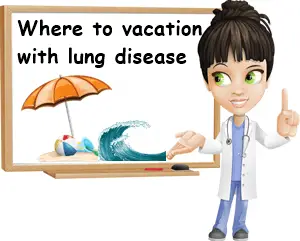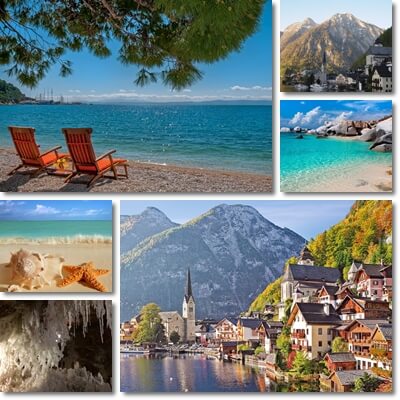Going on vacation with lung disease warrants certain considerations, like the need to weigh in travel options and choice of vacation destinations. For example, vacation destinations at high altitudes are generally bad for lung disease and certain means of transportation may pose difficulty while travelling in case you require to have medical equipment with you at all times. Weather conditions, humidity, having limited mobility or impaired breathing are other important factors to consider when going on vacation with lung disease.
How to go on vacation with lung disease. Different types of lung disease may impose certain travel and vacation restrictions. Depending on the nature of the disease and how advanced it may be, there are certain aspects you need to take into consideration well before going on vacation. Planning your holiday should be done in advance in order for your medical needs to be fully met both during traveling and the holiday itself, so that you may enjoy a relaxing time, rest and get your energy back.

What qualifies as lung disease? The following are some examples of lung diseases that may require special preparations for travelling and considerations when choosing a holiday destination:
1) Chronic obstructive pulmonary disease causing long-term narrowing of the airways, progressive shortness of breath and a productive cough.
2) Asthma, an inflammatory disease that affects the air passages that carry air into the lungs.
3) Bronchitis, causing the inflammation of bronchi, airway passages that carry air into the lungs.
4) Bronchiectasis, a chronic lung disease causing widened airways.
5) Cystic fibrosis with lung inflammation, mucus buildup, structural changes in the lungs, breathing problems.
6) Infectious lung diseases: tuberculosis, pneumonia (but not active).
7) Pulmonary fibrosis, a form of progressive lung disease.
Where to go on vacation with lung disease?
The best holiday destinations for someone with lung disease may include the following:
1) The seaside. A seaside holiday can be good for someone with lung disease. First of all, the seaside can be enjoyed without being too physically active, despite the availability of swimming, surfing and other highly demanding water sports practiced at the seaside. Lung disease sufferers often have breathing difficulties, scarring of the lung tissue, productive cough with mucus buildup and other problems that prevent them from practicing intense activities. They can simply take a walk on the beach and still enjoy the fresh air and relaxation.
Sunbathing at the seaside within reasonable hours and with appropriate sun protection can boost vitamin D production and improve immunity, which can be a great healing factor for a number of lung diseases. Anyone with frequent chest infections or other respiratory infections that could worsen existing lung conditions might benefit from sun exposure and vitamin D. Even autoimmune conditions have been shown to benefit from an increased vitamin D production as a result of sun exposure.
The clean, salty ocean air has been scientifically proven to help with sinus infections, clear mucus production, reduce wheezing and sinus pressure, calm coughing and improve asthma and bronchitis. The ocean air is an exceptional tonic for the lungs and overall respiratory system, hence the reason a seaside vacation would be a wonderful destination for someone with lung disease.

If the lung disease is not too advanced and your doctor agrees it would do you good, the ocean water can further help boost the immune system. If swimming is too demanding, and it is for most forms of lung disease, just being in the water may help. Lastly, the warmer temperatures you enjoy during a seaside holiday are beneficial for the respiratory system and help preserve respiratory health.
However, asthma sufferers have to pay attention to thermal shock which can occur if they sit in the sun, then get in the water too soon. The ocean water is generally colder and this difference in temperature can produce a severe asthma attack. If you are dealing with breathing difficulties, recovering from infections or are on oxygen, then it is important to refrain from physical activity, excesses and anything that may be too demanding for you respiratory system. Fortunately, just resting and taking in some sun can do wonders for your health, boost immunity, increase energy levels and reduce stress.
2) Salt mine health resort vacation. If your doctor allows it, then you may enjoy a healing vacation in a more unusual location: a salt mine health resort. A salt mine health resort is usually built around a salt extraction center and offers both interesting tourist attractions and a healing retreat for those with lung disease or respiratory problems in particular.
Some salt mine health resorts are located at high altitudes, the salt extraction center being a mountain of salt. Unfortunately, high altitudes are usually not recommended for people with lung disease, so talk to your doctor first if a holiday to a salt mine health resort in the mountains is safe for you. Other salt mines are situated at lower altitudes and these may be a better choice for someone with lung disease that is advised by their doctor to avoid mountain areas.
You can expect a variety of options from a salt mine health resort, from visits to underground galleries made entirely of salt to halotherapy sessions in salt chambers for pulmonary rehabilitation. Of course, you need your doctor to approve such a trip because going 50 to 100 meters underground to stroll through lengthy galleries made entirely of salt or sitting in an all-salt room can prove quite a shock at first, especially for someone with advanced lung disease or asthma.
From my experience, as soon as you descend in a salt mine, breathing may seem difficult as it some takes time to get used to the particular air there which seems to be filled with salt rather than oxygen. Spending some time in a salt mine is believed to be good for allergies, immune system disorders, sinusitis, respiratory infections, recovery following pulmonary infections, but also arthritis, ear infections and atopic dermatitis. Famous salt mines include: Hallstatt in Austria, Salina Veche Slanic (the old salt mine Slanic) and Turda salt mine in Romania, The Strataca Kansas Underground Salt Museum in Hutchinson, Kansas, United States.
Other considerations
What are other important considerations for traveling and choosing your vacation destination if you have lung disease? Here are 11 important things to think about before going on vacation with lung disease:
1) Plan your vacation ahead of time so that preparations can be made to accommodate the requirements of your disease (example: carry an oxygen tank with you, provide a wheelchair, other type of assistance).
2) Ask your doctor about the places you’d like to visit.
Find out if there are any travel, food, climate or other types of restrictions for your condition.
3) Know your disease and its particularities and have necessary papers with you at all times.
Example: copy of medical records, doctor’s letters, prescriptions, medicine labels etc.
4) Always carry your essential medication with you while travelling and visiting. Have backup medication with you just in case.
5) Talk to your doctor about the necessity of having a supplementary medication.
In case you lose your medicines, forget them in the car, in the sun, spill them etc.
6) Avoid remote areas with no immediate access to a medical facility. Plan you route for the day so that it accommodate your medical restrictions.
7) Discuss your condition with hotel staff so they will know how to handle a potential emergency or make your stay better (for example, make sure your room doesn’t have mold, provide a room for non-smokers).
8) Avoid going alone on vacation if your condition if advanced. It is always best to have a family member or friend with you in case you need help, as well as your doctor’s contact information.
9) Make sure you’re up to date with your vaccinations as per your doctor’s recommendations. But it’s best to avoid areas that pose increased risks for you.
10) Get travel insurance in case you are travelling far. Find out as much as you can about the places you are going, including access to medical facilities, proximity of medical facilities, emergency phone numbers etc.
11) Plan your vacation so you can enjoy several days of rest. When you have a chronic condition, it’s important not to rush anything and give yourself time to rest. Holidays can be tiring and take a toll on one’s health.
Conclusion
Depending on the type of lung disease you have and how advanced it is, there may be certain restrictions when it comes to going on vacation. What you need to know about traveling and going on vacation with lung disease is the importance of keeping your doctor informed about your travel plans and respecting the limitations imposed by your health condition. Just as important, make sure you have your essential medication with you at all times and plan your vacation so you have time to rest in order to avoid your condition worsening. As for the best vacation options for lung disease, the seaside and a pulmonary rehabilitation center in a salt mine health resort are the best destinations, but make sure you talk to your doctor first.
